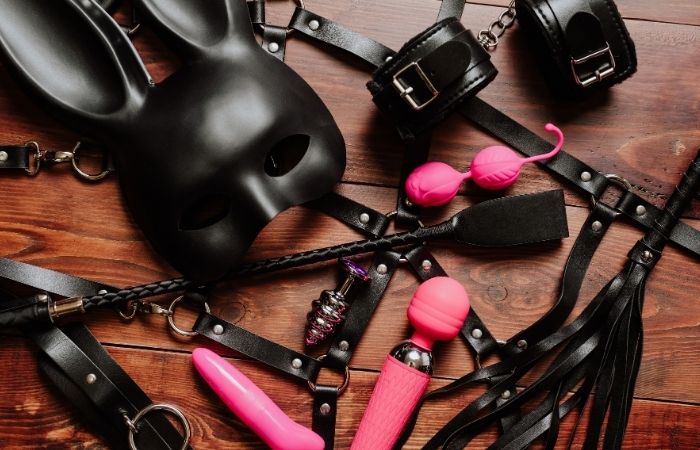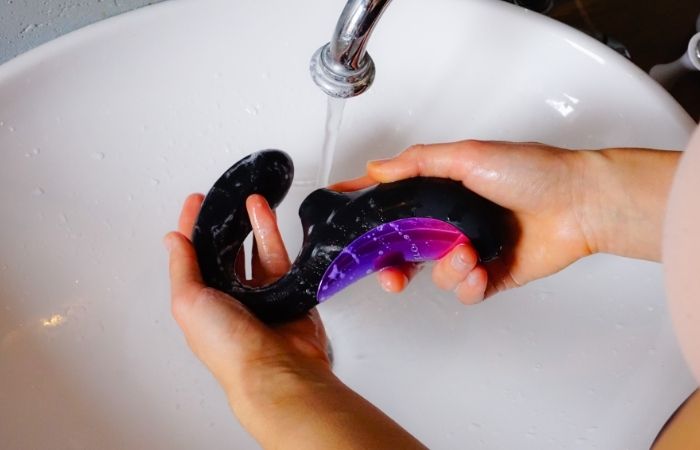The Numbers Don’t Lie Why Non-Sex Workers Often Have Higher Undiagnosed STD Rates
Quick Answer: If you don't clean sex toys properly between uses or partners, they can spread STDs like chlamydia, herpes, and HPV. Regular soap doesn't always work, and the best way to clean a toy depends on what it's made of and how it's used.
This Isn’t About Shame, It’s About Protection
Let's be clear: using sex toys doesn't make you irresponsible. But not following the right cleaning routines? That's when risk starts to show up, and not just for your pleasure. People don't talk about how sex toys can spread STDs very often, even though research has shown that infections like gonorrhea, trichomoniasis, and even HIV can live on surfaces for hours, and sometimes even longer, if the conditions are right.
One 2019 study published in the journal Sexually Transmitted Infections found that HPV DNA remained detectable on silicone toys even after cleaning with mild soap. That means your casual rinse might not be cutting it.
But here’s the thing: this article isn’t here to freak you out. It’s here to tell you what no one else is saying, because knowing how to properly clean your toys is one of the easiest ways to avoid avoidable infections.

People are also reading: Trichomoniasis vs Prostatitis: What’s Really Causing Your Symptoms?
“I Used a Toy After My Partner, Now I Have Gonorrhea”
Marco, 27, had always assumed condoms were enough. But one night, he and his boyfriend shared a silicone anal toy without thinking to clean it between uses. A week later, Marco noticed an unusual discharge and painful urination. A test confirmed he had gonorrhea.
“I didn’t even have penetration that night. It was just the toy. I had no idea that was enough to get infected.”
This isn’t rare. Any object that touches mucous membranes, vaginal, anal, or oral, can carry infectious cells, especially when passed between partners. And unless you’re cleaning it like a medical instrument, the risk doesn’t disappear.
Even solo users can reinfect themselves if toys are improperly cleaned after a yeast infection or bacterial vaginosis episode. The threat isn’t just theoretical, it’s chemical, biological, and backed by science.
What Actually Lives on Your Sex Toys?
Bacteria, viruses, and fungi don’t care if you’re in love or just experimenting. Here's what can linger on unwashed, or poorly washed, toys:
Table 1. Common pathogens that may survive on sex toys and the infections they can cause.
The surface, material, and whether the toy is porous or non-porous all affect how long these pathogens stay active. That's why cleaning technique matters just as much as timing.
Not All Toys Are Created Equal: Material Matters
Some toys are easier to clean, and safer, than others. The main dividing line? Porosity.
Porous toys (think jelly rubber, latex blends, soft plastic) can harbor bacteria and bodily fluids even after you wash them. That means they’re never 100% clean unless covered with a condom during use. Non-porous toys (like silicone, glass, metal, and hard plastic) don’t absorb fluids and are much easier to fully sanitize.
And don’t assume “expensive” means “safe.” Some high-end toys are still made with porous materials that feel good but clean poorly. Read labels. Ask questions. Your vulva, rectum, and immune system will thank you.
The 6 Most Common Cleaning Mistakes (That Can Spread STDs)
Most people don’t skip cleaning entirely, they just do it wrong. Here are the biggest hygiene errors that allow bacteria, viruses, and fungi to hang around even after a rinse:
Table 2. Common mistakes that reduce cleaning effectiveness and increase STD transmission risk.
Good intentions don’t equal good outcomes when it comes to sex toy care. But don’t stress, cleaning properly doesn’t have to be complicated. You just need the right process.
How to Clean Sex Toys the Right Way (By Material)
Different materials need different approaches. Here's a breakdown of how to clean safely without damaging the toy, or your body:
Table 3. Cleaning recommendations based on sex toy materials and safety considerations.
If you're ever unsure, check the toy manufacturer's cleaning guidelines. When in doubt: use warm water, fragrance-free soap, and dry completely before storage.
What Actually Kills STDs on Toys?
Most STDs won’t die just because your toy “looks clean.” They need to be destroyed with heat or the right disinfectant. Here’s what works, and what doesn’t:
Table 4. Disinfection methods and their effectiveness against pathogens commonly found on sex toys.
Bleach and boiling are the gold standards, if the toy can handle them. UV devices can help, but they’re not magic wands. Read the label. Know your tools.
How Often Should You Clean Sex Toys?
Before and after every use. Yes, every single time, even if it’s just you. Bodily fluids, lube residue, and microscopic bacteria don’t disappear just because it’s “your” toy.
Here’s a good rule of thumb:
If it goes inside your body, clean it like it’s going into someone else’s.
Also important: clean your hands first. If you touch the toy with contaminated fingers, you’ve already introduced new risk, even before you turn it on.

People are also reading: When Endometriosis Symptoms Might Actually Be Chlamydia or PID
Storage: The Forgotten Hygiene Step
You can sanitize a toy perfectly, then ruin it by shoving it into a drawer with old socks and lint. Always dry toys completely and store them in breathable cloth bags or individual containers, ideally away from heat, light, and humidity.
Avoid plastic wrap or airtight containers unless the toy was factory-sealed that way. Trapped moisture = bacteria playground. If it smells weird, clean it again before use.
Still unsure which toy or cleaner is right for you? Don’t risk it. This combo STD test kit checks for the most common infections discreetly, because peace of mind is cleaner than any soap.
Sharing Isn’t Always Caring: What Happens When You Use Toys With a Partner
Using toys with a partner can be hot, intimate, and affirming, but it also comes with real risks if you’re not protecting both of your bodies. STDs like HPV, gonorrhea, and chlamydia don’t need skin-to-skin contact to spread. They just need shared fluids and a contaminated surface. That’s exactly what an unclean toy becomes.
Whether it’s oral-to-vaginal, anal-to-anal, or any combination of play, the toy becomes a carrier if used without a barrier or cleaned in between. Even lube doesn't protect you, especially if it's already on the toy from a previous use.
If you’re sharing toys, here’s what to do:
- Use a new condom or barrier on the toy for each person.
- Clean thoroughly between uses, ideally mid-session.
- Have an honest talk about testing history, comfort, and STI risks.
It’s not about policing pleasure, it’s about protecting it. Keeping things sexy and safe can absolutely coexist. That’s the power of being informed.
What to Do If You’ve Already Shared an Unclean Toy
If you're reading this and just realized you might have made one of these mistakes, take a deep breath. You’re not alone. Tons of people find out after the fact that toy hygiene matters more than they thought.
Here’s what to do now:
Watch for symptoms
Things like discharge, itching, burning, sores, or unusual odors can appear anywhere from days to weeks after exposure. But remember, not all STDs cause symptoms right away.
Get tested
If you think there’s a risk, or you’re just not sure, a discreet at-home test is a no-pressure way to find out. Consider something like the Combo STD Home Test Kit, which covers multiple common infections in one go.
Talk to your partner(s)
If you've used the same toy with someone else recently, let them know about the risk. These conversations are awkward, but they’re also compassionate. Shared pleasure means shared responsibility.
Disinfect the toy now
Don’t wait until symptoms show up. Whether you use boiling, bleach, or a toy-specific cleaner, clean it fully and store it safely. If that toy is made of a porous material and you shared it without a condom or cleaning? Retire it. No orgasm is worth the mystery microbes living inside it.
Why Nobody Talks About This (But We Should)
There’s a lot of silence around sex toy hygiene, especially in mainstream sex ed. Many people feel ashamed for even owning toys, let alone talking about cleaning them. And that shame leads to silence, which leads to risk.
We’re here to say: there’s no shame in pleasure. There’s no shame in safety. You can enjoy your sex life, explore your body, and care for your health at the same time. In fact, they go hand in hand.
If you’re not sure whether something was safe or not, or you just want peace of mind, testing is always an option. No judgment. Just answers.
STD Test Kits offers fast, private options you can do from home, without a lecture or an awkward waiting room.
“I Didn’t Know You Could Get an STD from a Toy”
Shayla, 32, had never been tested for trichomoniasis.
“I always thought that was a ‘clinic STD’ or something,” she says. “I’d been using this vibrating dildo solo and sometimes with my girlfriend. We were monogamous, but I had no idea the toy could pass stuff back and forth.”
After some unexplained itching, Shayla finally got tested, and tested positive. “It was a total surprise. But once I knew, I could treat it. Now I boil my toys or use condoms on them. I just wish someone had told me this sooner.”
Let this be that “someone” for you. You don’t have to learn the hard way.

People are also reading: Can You Get Trich Without Cheating?
FAQs
1. Can sex toys really spread STDs?
Yes, and it’s not just scare tactics. If a toy goes from one body to another without proper cleaning or protection, it can carry infections like chlamydia, gonorrhea, HPV, and more. Think of toys as part of your body during play. If you wouldn’t share a toothbrush without cleaning it, don’t share a dildo without washing it (or covering it with a fresh condom).
2. I only use toys by myself. Do I really need to clean them every time?
Yes, even solo sessions count. Leftover lube, vaginal fluids, or even small amounts of blood (especially during periods or rough play) can invite bacterial overgrowth. Plus, if you’ve ever had BV, a yeast infection, or anything lingering, you don’t want to reintroduce that mess later. Treat your toy like your favorite kitchen tool: clean before and after, even if it only touched “your stuff.”
3. What’s the deal with porous toys? Are they just...bad?
Porous toys aren’t evil, but they are risky. Materials like jelly rubber, TPE, and some soft plastics can absorb fluids into their surface. That means even if they look clean, stuff can be living inside them. If you use them, always put a condom on, and retire them when they start to smell weird, feel tacky, or lose their shape. Honestly, if you can afford it, switch to silicone, glass, or stainless steel. They’re cleaner, safer, and last longer.
4. Is boiling a toy really safe?
Only for the right materials! You can boil medical-grade silicone, glass, and metal toys that have no motors or batteries for 3–5 minutes to kill most bacteria and viruses. It’s like giving your toy a spa day. But don’t boil your vibes or your wands unless you like melted plastic and tears. Always check if your toy is motor-free and boil-safe before tossing it into a pot.
5. Can condoms make toy play safer?
Big yes. Condoms are MVPs when it comes to shared toys or switching between partners (or between anal and vaginal use). Just remember: change the condom between people, and don’t assume it replaces cleaning. It’s a layer of safety, not a full disinfectant. Think of it like a glove, not a magic shield.
6. I wiped my toy with a Clorox wipe. Is that enough?
Ehh... not really. Wipes are okay in a pinch, especially for non-porous toys, but they don’t replace real cleaning. If the toy is silicone, glass, or hard plastic, you’ll still want to wash it with warm water and soap afterward to remove chemical residue. Plus, those wipes aren’t tested for vaginal or rectal safety. When in doubt, go gentle and thorough, not just fast.
7. I used a toy with someone and we didn’t clean it. Should I be worried?
Not gonna sugarcoat it: there’s a risk. But don’t panic. Watch for symptoms, yes, but remember that many STIs don’t show signs right away (if at all). The smart move? Get tested in a couple weeks, or sooner if something feels off. Grab a combo test kit and keep it discreet. Better to know than wonder.
8. Do I need fancy toy cleaner, or is soap good enough?
You don’t need to drop $$$ on “intimate toy cleanser.” Unscented, gentle hand soap and warm water work wonders for most non-porous toys. The key is consistency and thoroughness. That said, if you find a toy cleaner that makes you feel pampered and safe, go for it. Just skip anything with fragrances, alcohol, or glitter (seriously, there are glitter sprays now. Stop it).
9. How should I store my toys?
Dry them completely. Then give them their own space. No shame drawer with lint and forgotten lip balm. Use cloth bags or clean containers, ideally one per toy. Some people tuck silica packets inside to keep things extra dry. And if your toy smells funky when you pull it out again? Wash it before use. Funky = flora.
10. Can toys cause yeast infections or BV?
Yes, especially if they’re porous, not cleaned properly, or go from backdoor to front door without a barrier. If you’ve had recurrent yeast or BV and haven’t changed your toy hygiene, that might be your hidden culprit. Clean smarter, use condoms on shared or porous toys, and consider retiring older ones with battle scars.
You Deserve Pleasure, Without the Panic
No one taught most of us how to clean sex toys. But you’re here now, taking control of your sexual health with curiosity and care, and that matters. Whether you're flying solo, playing with a partner, or just buying your first toy, remember this: Clean toys mean safe pleasure. You don’t need fear. You need facts, and the freedom to enjoy yourself without second-guessing.
If you’ve made a mistake or shared a toy you’re unsure about, it’s not too late. This at-home combo STD test kit can give you the peace of mind you deserve, quickly and privately.
How We Sourced This Article: We combined current guidance from leading medical organizations with peer-reviewed research and lived-experience reporting to make this guide practical, compassionate, and accurate. In total, around fifteen references informed the writing; below, we’ve highlighted five of the most relevant and reader-friendly sources.
Sources
1. Everything You Need to Know About Sex Toys and STIs | Healthline
2. How to Clean Your Sex Toys (Hims)
3. Sex Toy Safety Guide | LGBTQIA Midwest
5. Detection of HPV on Shared Vaginally-Inserted Sex Toys & Effect of Cleaning Practices | PubMed
About the Author
Dr. F. David, MD is a board-certified infectious disease specialist focused on STI prevention, diagnosis, and treatment. He blends clinical precision with a no-nonsense, sex-positive approach and is committed to expanding access for readers in both urban and off-grid settings.
Reviewed by: Layla E. Monroe, MSN, NP-C | Last medically reviewed: September 2025
This article is for informational purposes and does not replace medical advice.







